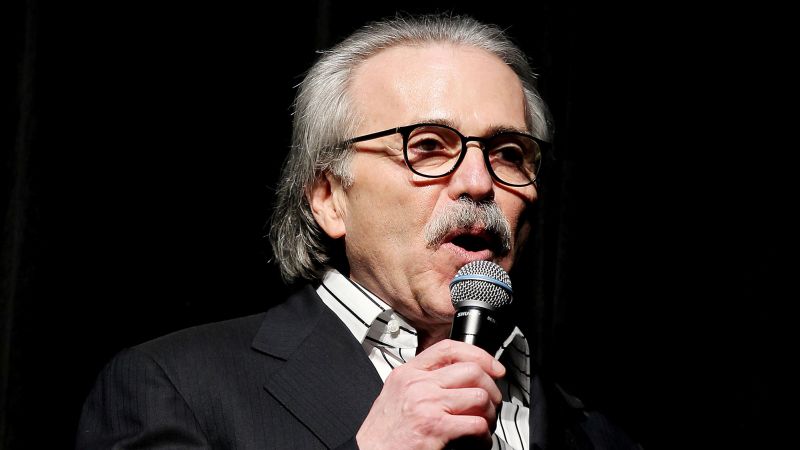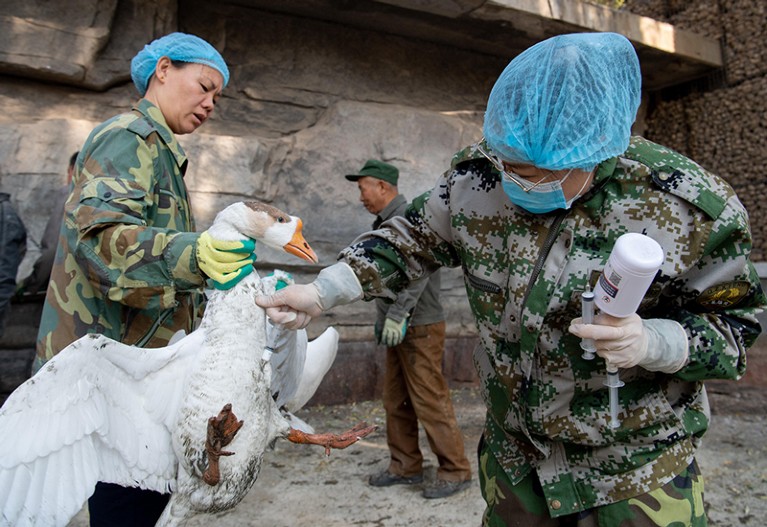A goose being vaccinated against avian influenza in China.Credit: Wei Liang/China News Service/Getty
Fears are rising about bird flu’s potential to spark a human pandemic, as well as its destruction of wildlife and farmed birds. An 11-year-old girl tragically died in Cambodia last week after catching avian influenza. That followed reports earlier this year of the virus spreading from mammal to mammal through a mink farm, and causing mass mortality in Peruvian birds and sea lions. Since the beginning of 2022, more than 50 million poultry birds in the United States, and a similar number in Europe, have either died of the disease or been killed in efforts to stem its spread. Can bird flu be stopped, and if yes, how?
Protecting poultry
Poultry farms are a key battleground in the fight against H5N1, the strain of avian influenza that is currently circulating. Outbreaks on farms threaten food security and provide opportunities for the virus to spread to farm workers. For decades, farmers have controlled the disease by culling infected animals. But now, with many countries experiencing outbreaks on dozens of farms every month, this is becoming untenable.
Some countries, including China, vaccinate poultry to limit the spread and severity of bird flu, and other governments around the world are now implementing vaccination policies or contemplating doing so. One problem with existing vaccines is that they cause birds to test positive for the virus, meaning farmers can’t guarantee their birds are free of H5N1. This has “huge international trade and export implications”, says Keith Poulsen, a specialist in infectious diseases who directs the Wisconsin Veterinary Diagnostic Laboratory in Madison.
Scientists are in the early stages of developing vaccines that might solve this problem. Microbiologist Adel Talaat at the University of Wisconsin–Madison and his colleagues are developing a vaccine that uses only a small part of the virus’s DNA. Tests targeting other genetic regions could differentiate between birds that have been vaccinated and those that are infected.
Poultry farmers could also raise a wider variety of bird breeds in order to stop the virus, says Nichola Hill, an ecologist at the University of Massachusetts in Boston. In Asia, where farmers have a long history of navigating outbreaks of bird flu, some have switched to breeds that are less susceptible to the virus.
Conserving wildlife
H5N1 has become entrenched in wild bird populations over the past year, but there are “some small Band-Aids we can put on things”, says epidemiologist David Stallknecht at the University of Georgia in Athens. Administering vaccines to wild birds is logistically difficult. So, for the most part, birds have to develop resistance to the disease through being infected, and many will die in that process.
Vaccines could help to protect certain species, Stallknecht says. Bald eagles (Haliaeetus leucocephalus), for example, can be severely affected by the virus, and some scientists are worried about the long-term impact of bird flu on the population. But the strategy could only be used for species under grave threat when “you’re doing everything you possibly can to keep them on the planet”, he says.
At the moment, Stallknecht and other wildlife researchers are trying to understand which species of wild bird are most severely affected by avian flu, and the implications this has for the spread of the disease. As well as helping scientists target conservation measures, this research could give farmers a better idea of when bird flu might be heading their way, if, for example, it is combined with when certain birds are known to migrate.
That knowledge could help farmers target measures to protect poultry, such as cleaning up grain that could attract wild birds and washing boots before entering farms. “It’s extremely hard to do that 365 days of the year,” Hill says. Shorter time frames are more feasible.
Stopping a human pandemic
The death of the girl in Cambodia — and the fact that her father also tested positive for avian influenza — has renewed concerns about whether bird flu could spark widespread infection in people, or even a pandemic. “That’s hard to say,” says Thijs Kuiken, a veterinary pathologist at the Erasmus University Medical Center in Rotterdam, the Netherlands.
Ancestral versions of today’s H5N1 virus have been circulating among birds for about 25 years and have not yet gained the ability to spread between humans. That leads Kuiken to think that the risk of a human pandemic is low. But the recent uptick in cases among wild birds, and the discovery that the virus can be transmitted between mammals, increase the risk that the virus could start spreading in humans. Kuiken would like to see increased surveillance of people who work in the poultry sector to make sure anyone who becomes infected is quickly detected and isolated.
If bird flu does trigger a human pandemic, there are a number of tools for combating the disease. Approved human vaccines against avian flu exist, and the World Health Organization monitors the evolution of H5N1 so that these vaccines can be updated appropriately. In the United States, the Biomedical Advanced Research and Development Authority has a stockpile of vaccines, although the supply is too low to be used to vaccinate the world. Animal studies and observational data in humans suggest the antiviral drug Tamiflu is effective against H5N1 in people1, although there have been reports of resistant strains2. Non-pharmaceutical tools including face masks can also limit disease spread.
For a world still reeling from COVID-19, the prospect of another pandemic is alarming. Bird flu’s current mortality rate in humans is around 50%, although that would be likely to drop if the virus gained the ability to infect cells in the upper respiratory tract — a prerequisite for efficient human-to-human spread. But several scientists say that an H5N1 pandemic would probably be more manageable than COVID-19 because of the drugs and vaccines that are already available, and because of tools such as mRNA vaccines that were developed as a result of COVID-19. “Not to say it won’t be a mess,” says Stallknecht, “but it probably won’t be as bad as it could be.”
Hill agrees that humanity has the tools needed to keep the virus in check. “The question is control at this point, and preventing a human pandemic,” she says. “And I think both of those are achievable goals.”








More News
Judge dismisses superconductivity physicist’s lawsuit against university
Future of Humanity Institute shuts: what’s next for ‘deep future’ research?
Star Formation Shut Down by Multiphase Gas Outflow in a Galaxy at a Redshift of 2.45 – Nature